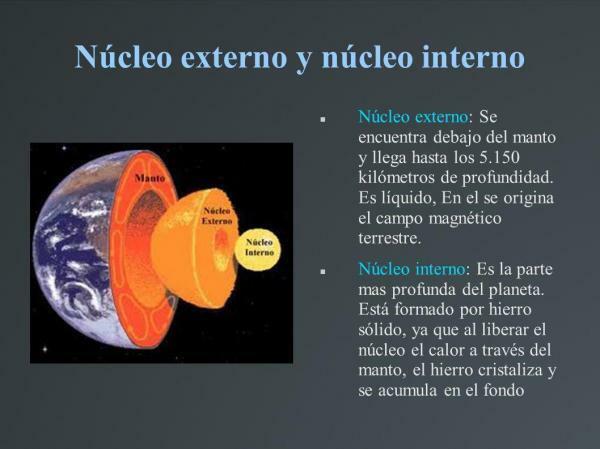Core of the Earth: definition and characteristics

Image: ElPais
Many centuries ago for people it was a mystery what was found under the ground, being the motive of tales and stories what could be found in the center of the Earth. Today, we know what the core of the planet is made of and what are the causes of its formation. To know the center of our planet, in this lesson from a TEACHER we are going to talk about the definition and characteristics of the Earth's core.
Within all parts of the earth, we have to know that the nucleus is a sphere that is in the innermost area of the terrestrial structure. It is made up of different elements such as nickel, sulfur or oxygen, although the element that has the most presence in its composition is iron.
The core of the Earth is vital for human beings, since if the nucleus did not exist we would have no chance of survival. This is due to the core is responsible for creating magnetic currents, and without the creation of these currents our magnetic field could not defend us, which would lead to the death of human beings.
Regarding their training, we must remember that Earth is 4.6 billion years old. At first the Earth was just a huge liquid ball and very hot, with a very different composition than today. Little by little other elements formed in the Solar system collided and some ended up joining the Earth. Then began a process called planetary differentiation, in which the densest elements went towards the center and the lighter ones stayed in the crust.
All this process over millions of years caused the core of the Earth to form.

Image: astroyciencia
To better understand the core, we must talk about the different characteristics that make it unique. Some of the main characteristics of the nucleus are the following:
- The core density should be around 11,000 kg / m3.
- Part of the core is made up of remnants of meteorites that hit Earth.
- The elements with the greatest presence in the nucleus are nickel and iron, but there are also other light elements such as oxygen.
- The radius must be between 3,200 and 3,500 kilometers.
- Represents the 60% of the mass from the earth.
- Formerly it was called NiFe due to its great composition of nickel and iron.
- It can also be called endosphere.
- Its temperature can exceed 6,700 ºC.
- Its pressure is millions of times higher than the pressure at the surface.
- The heat of the core is due to the excess heat of the planet formation and the decomposition of radioactive elements.
To conclude this lesson with the definition and characteristics of the Earth's core, we must talk about the two parts into which the nucleus is divided and the characteristics of each of these parts. The Earth's core is divided into two parts, a 2,270 km thick outer core and a 1,220 km thick inner core. Both cores are divided by the Lehmann discontinuity, which is at a depth of 5155 kilometers.
Earth's outer core
The outer core is a liquid layer formed by iron and nickel, located between the inner core and the mantle, and therefore being the most superficial area of the core. The liquid situation of this part is due to the fact that seismic waves cannot pass through the outer core. Its temperature varies from 4400 ºC to 6100 ºC, depending on the area we are talking about. An important fact about this part of the nucleus is that its convection together with the Earth's rotation causes the Earth's magnetic field.
Inner core
On the other hand, there is the inner core, which is in a solid state and is made up of iron and nickel. It is located in the center of the Earth, having a radius of 1216 km and being at a temperature of between 5000 and 7000 ºC. Its temperature is so high that it cannot sustain a magnetic field, although it is believed that it can function as a kind of stabilizer for the magnetic field generated by the outer core.




